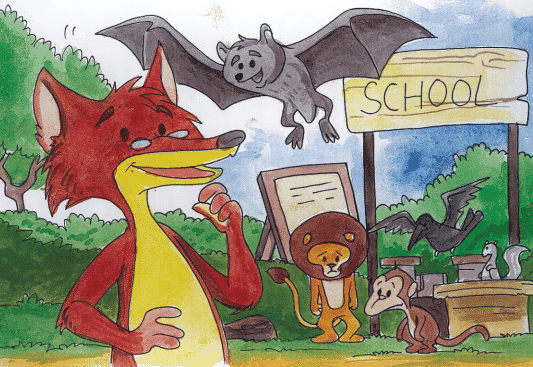Inclusive Education Chapter Notes | Communicative English for Class 10 PDF Download
| Table of contents |

|
| Key Points of the Story |

|
| Detailed Summary |

|
| Theme/ Message |

|
| Difficult Words |

|
Key Points of the Story
- Fox is very happy because more than 50 animals have joined his new school in the jungle.
- Fox wants to make the school the best in the jungle, so he includes many subjects in the curriculum like reading, writing, and swimming.
- Fox insists that teachers must teach regularly and give tests to the students.
- The teachers are not happy because they find it difficult to teach some animals, like the lion who cannot swim and the tiger who cannot climb trees.
- Even though the teachers try hard, many students, like the crow and the pig, do not succeed in their classes.
- Fox is worried because all the animals fail in their exams.
- A wise bat suggests that the students should choose the subjects they like, which will help them learn better.
- The monkey does not have to learn swimming anymore, and other animals can focus on what they enjoy.
- When the exams are held again, all the animals pass with great success.
- Fox is very proud of his school because all the students did well.
Detailed Summary
Once upon a time in a jungle, there lived a happy Fox who was excited to start a new school. Over 50 animals joined, and Fox wanted to make it the best in the jungle. He planned to teach various subjects, including reading, writing, math, swimming, dancing, running, and climbing trees. Fox instructed the teachers to hold regular classes and give tests to assess the students' learning.
However, the teachers faced challenges. Some animals struggled with certain subjects; for instance, the lion couldn’t learn to swim, and the tiger had difficulty climbing trees. The crow refused to sing during music classes, which worried the teachers. Despite their hard work, many animals were not learning as expected, leading to a disappointing outcome when all students failed their exams. This made Fox anxious about the success of his school.

One day, a wise bat approached Fox with a suggestion. The bat advised Fox to allow the animals to choose what they wanted to learn. This idea transformed the school’s approach to education. The monkey, who was skilled at climbing, no longer had to learn swimming. The crocodile, who enjoyed the water, could focus on swimming and diving. The crow could learn to fly and perform tricks in the sky, while the squirrel continued with arithmetic, which he loved.
When the exams were held again, the results were remarkable. All the animals passed their exams with flying colors, indicating they had done exceptionally well. Fox felt proud of his school, as the new approach made the animals happy and engaged in their studies. They were now able to explore subjects they enjoyed, showcasing their individual strengths and interests.
Thanks to the bat’s wise advice, Fox learned a valuable lesson: it’s important to let individuals choose their learning paths. By allowing the animals to pursue what they were passionate about, the school became a thriving environment. The jungle was filled with happy animals who could swim, dance, read, and climb trees in their unique ways.
This story emphasizes the significance of personalized learning and the joy that comes from discovering one’s passions. Everyone is different, and recognizing these differences makes learning enjoyable and fulfilling.
Theme/ Message
- The main theme of the story is the importance of allowing individuals to follow their interests and strengths.
- It shows us that everyone has different talents, and forcing them to learn things they do not like can lead to failure.
- The story teaches that education should be tailored to each student's needs, allowing them to succeed in their own way.
- Another important message is that teamwork and understanding among teachers and students can lead to better learning experiences.
Difficult Words
- Admissions: The process of allowing students to enter a school.
- Curriculum: The subjects and courses offered in a school.
- Regularly: Happening at fixed times or frequently.
- Unsatisfied: Not happy or content with something.
- Methods: The ways or techniques used to do something.
- Conduct: To lead or manage something.
- Exams: Tests to measure knowledge or skills.
- Wise: Having good judgment and knowledge.
- Practice: To do something repeatedly to improve skills.
- Flying colours: A phrase meaning to pass with great success.
- Determined: Having a strong decision to achieve something.
- Students: The learners or pupils in a school.
- Special: Different from the usual or ordinary.
- Climbing: The act of going up something high.
- Failures: Not succeeding in achieving a goal.
|
8 videos|250 docs|8 tests
|
FAQs on Inclusive Education Chapter Notes - Communicative English for Class 10
| 1. What is inclusive education? |  |
| 2. Why is inclusive education important? |  |
| 3. What are some challenges faced in implementing inclusive education? |  |
| 4. How can teachers support inclusive education in the classroom? |  |
| 5. What role do parents play in promoting inclusive education? |  |














